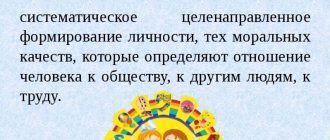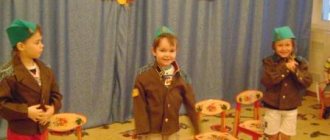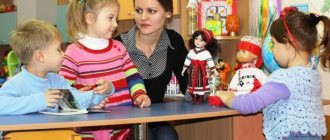Aesthetic education of preschool children
It has long been known that for the harmonious development of personality, a child must be comprehensively developed. Aesthetic education provides an integrated approach to personal development; it includes labor and moral education. It permeates all spheres of a person’s life: the depth of his thinking, the subtlety of feelings, the nature of selectivity and attitude, etc.
Aesthetic education is a purposeful, systematic influence on a person with the aim of his aesthetic development, that is, the formation of a creatively active personality, capable of perceiving and appreciating the beauty in nature, work, social relations from the standpoint of an aesthetic ideal, and also experiencing the need for aesthetic activity. Aesthetic education is the process of developing a person’s aesthetic attitude to reality. With the emergence of human society, this attitude developed along with it, embodied in the sphere of material and spiritual activity of people. It is associated with their perception and understanding of the beautiful in reality, their enjoyment of it, and the aesthetic creativity of man. In other words, aesthetic education is a purposeful, systematic process of influencing a child’s personality in order to develop his ability to see the beauty of the surrounding world, art and create it. It starts from the first years of children's lives.
Aesthetic education is a very broad concept. It includes the education of an aesthetic attitude towards nature, work, social life, everyday life, and art. However, the knowledge of art is so multifaceted and unique that it stands out from the general system of aesthetic education as a special part of it. Raising children through the means of art is the subject of artistic education. Aesthetic education is closely related to all aspects of education. The relationship between aesthetic and moral education and development is revealed by the fact that ethical and aesthetic ideas are associated with positive and negative human experiences. For example, the joy that overcomes a person when perceiving beauty is very similar to the feeling of pride when committing a moral act. On the contrary, disgust and contempt are caused not only by ugly actions, but also by their figurative reflection in one form or another of art. The educational power of art lies in the fact that it makes a person deeply experience a wide variety of feelings: delight and indignation, sadness and joy, anxiety and peace, love and hatred, and treat similar phenomena in real life accordingly.
The educational significance of all types of art in the formation of the foundations of patriotism is great: children are imbued with love for their native nature, native land, city, are proud of the results of the work of their parents, and gradually become familiar with the concept of the Motherland. Also, aesthetic education is closely related to labor education. By transforming this or that material into a useful thing, a person rejoices, feeling his increasing strength. In the process of artistic and creative activity, memory is improved, especially visual and musical. Thus, in drawing, children reflect what is stored in their visual memory. In the process of aesthetic and artistic activity, mental operations are also improved: synthesis, analysis, comparison, mental abilities and the ability to plan one’s activities are developed. This promotes mental development, which, in turn, ensures the child’s full aesthetic education.
In the process of implementing aesthetic education, it is necessary to solve the following tasks: systematically develop aesthetic perception, aesthetic feelings and ideas of children, their artistic and creative abilities, and form the foundations of aesthetic taste. It is important that the teacher’s work is built on a scientific basis and carried out according to a specific program that takes into account the current level of development of various types of art, in compliance with the principle of gradualism, consistent complication of requirements, and a differentiated approach to the knowledge and skills of children of different ages.
Aesthetic education presupposes, first of all, the presence of an aesthetic ideal, an idea of the perfect, perfection in art and reality. For example, one person may see the aesthetic ideal of art in a generalized and perfect reflection of life itself and human relationships in it, in the depiction of its progressive tendencies aimed at improving people and society. Another can see it only in the perfection of forms, artistic techniques of expression by the artist of his subjective experiences. The aesthetic ideal is socially determined and represents a social pedagogical phenomenon. An aesthetic ideal can also express an idea of the perfection of human beauty, human relationships (ethics), and labor (technical aesthetics, design).
So, the tasks of aesthetic education of preschoolers, based on its goal, can be presented in two groups.
- The first group of tasks is aimed at developing children’s aesthetic attitude towards their surroundings. The following is provided: to develop the ability to see and feel beauty in nature, actions, art, to understand beauty; cultivate artistic taste, the need for knowledge of beauty.
- The second group of tasks is aimed at developing artistic skills in the field of various arts: teaching children to draw, sculpt, design; singing, moving to music; development of verbal creativity.
The named groups of tasks will give a positive result only if they are closely interconnected in the implementation process.
The leading methods for solving problems of the first group are demonstration, observation, analysis, and the example of an adult. Showing as a method of education is used during initial acquaintance with the subject of aesthetic reality. It is important for the teacher to determine the object of the display and create conditions so that the children’s attention is focused on what they are shown and asked to listen to.
When using these methods, it is very important that the teacher knows how to show his feelings, his attitude, and knows how to express feelings. The expressiveness of the intonation of the poem, sincere admiration for a beautiful thing, genuine grief when encountering negligence in clothing, sloppiness, a bright emotional manifestation of one’s feelings by an adult serves as an active method of influencing a child, since it is based on a feature of childhood - imitation.
To solve problems of the second group, practical methods are required as leading ones: demonstration, exercise, explanation, method of search situations. These methods are discussed in detail in the methods of visual activity and music education.
The general principle for selecting methods is to find methods and techniques that would support children’s desire to create “works of art” with their own hands (sculpt, draw, craft, decorate), and participate in various types of artistic activities. Creative tasks are useful; they and any manifestation of creativity must be combined with teaching the skills of artistic expression. If a child does not have drawing skills, he will not be able to create something creative, despite the conventional understanding of this term in relation to preschoolers. That’s why direct teaching methods are needed: demonstration, exercise, examination of objects, description. In these cases, learning becomes one of the factors that stimulate creativity, and creative tasks give learning a developmental character.
Artistic taste is inextricably linked with the aesthetic ideal, as part of aesthetic education. It is also a social phenomenon and is influenced by social class relations. Artistic taste is the developed ability to feel and evaluate perfection and imperfection, unity or opposition of content and form in art and life. Like the aesthetic ideal, artistic taste can be present in children at different levels, thereby largely determining the level of aesthetic education.
An important sign of aesthetic education is the developed ability to admire beauty, perfection in art and life. Closely related to the element of admiration is the general ability to deeply experience the feelings generated by an aesthetic object. The emergence of a range of sublime feelings and deep spiritual pleasure from communicating with the beautiful, a feeling of disgust when meeting the ugly, a sense of humor, sarcasm at the moment of contemplating the comic, feelings of anger, fear, compassion that arise as a result of experiencing the tragic - all these are signs of genuine aesthetic education.
Aesthetic taste is manifested in the fact that a person receives pleasure, spiritual pleasure from meeting true beauty in art, in life, in everyday life. Aesthetic taste is a broad concept; it includes not only understanding, enjoying deep, beautiful works of art. But also an understanding of the beauty of nature, work, life, clothing. Education plays a big role in the formation of aesthetic taste in children. In classes, preschoolers are introduced to classic works of children's literature, music, and painting. Children learn to recognize and love true works of art accessible to their age.
Getting acquainted with a folk tale, with the works of S.Ya. Marshak, S.V. Mikhalkov, K.I. Chukovsky, listening to the works of P.I. Tchaikovsky, D.B. Kabalevsky and other composers, children begin to become familiar with the beauty and richness of artistic words, music. All this gives them true pleasure, is remembered and forms the foundations of artistic taste. By instilling in children the basics of aesthetic taste, we teach them to see and feel the beauty of the world around them, and to cherish it. It is better to keep a flower in a flowerbed, but in order for it to bloom and bring joy to others, it must be looked after. Cleanliness in the group, which creates comfort and beauty, must be maintained, not littering, and putting away toys and books. Thus, in the process of education and training, the tasks of aesthetic education in preschool age are carried out.
Aesthetic education of children is carried out by familiarizing children with the aesthetics of everyday life, with the beautiful in work, in nature, social phenomena, and the means of art. Teaching a child to feel and understand the beauty of life is a big and difficult task that requires long-term work by adults. To implement the tasks of aesthetic education of children, certain conditions are necessary. First of all, this is the environment in which the child lives and develops. It has an impact on the child that can hardly be compared with others in its strength and significance. If the environment is aesthetic, beautiful (not necessarily rich), if the child sees beautiful relationships between people, hears beautiful speech, etc., then from an early age he will accept the aesthetic environment as the norm, and everything that differs from the norm will cause he has aversion. The aesthetics of everyday life includes many details. This is the aesthetics of the environment: the things that surround the child and which he uses, toys, clothes of the baby and the people around him, the design of the premises, etc. Beautiful things “please the eye”, evoke positive emotions and a desire to preserve them. The “white tablecloth” theory is quite fair: if we want to cultivate not only neatness, but also the need for an aesthetic environment, we must exclude non-aesthetics as such. From the first years of a child’s life, it is important both at home and in a preschool institution to pay attention to the aesthetics of everyday life.
The concept of “everyday aesthetics” also includes the beauty of everyday relationships between people who surround the child. It is very important what kind of speech he hears, what intonations. It is necessary that it be correct, figurative, rich in intonation and friendly. The aesthetics of everyday life is also a person’s appearance. Carelessness, untidiness in clothing, awkwardness in the selection of colors, inability to find your own style - all this is contrary to the law of beauty. The aesthetics of everyday life is an indispensable condition for the aesthetic education of a child, the background that reinforces or destroys his or her ideas about beauty. Three rules: to live in beauty, to notice beauty, to support and create beauty around oneself - make the aesthetics of everyday life a means of aesthetic education of a child.
Nature is a powerful means of aesthetic education. It is in it that you can see harmony - the basis of beauty: a variety of colors, shapes, sounds in their combination. Nature itself is a condition for the comprehensive education and development of a child. It becomes a means when an adult purposefully uses its “educational potential” and makes it visible to the child. The teacher reveals to children the world of nature, helps them see its beauty in a drop of dew on a bud, and in the interweaving of grasses, and in the colors of the sunset... You just need to see this beauty for yourself and find words that are accessible to the child’s heart. Works of art about nature will provide him with invaluable help in this, which he must know well and skillfully use. In education using the means of nature, it is necessary not only a passive contemplative, but also an effective principle (to protect nature, to help it).
Social life, the work of people with whom the child constantly encounters, is also an important means of aesthetic education. The well-coordinated work of builders makes children want to create a good building, act together, and be attentive to each other. Descriptions of the work of sailors, pilots, teachers, and doctors not only introduce preschoolers to these professions, but also make them want to imitate them. All this is reflected in their games and contributes to the education of moral and aesthetic feelings. Therefore, the teacher thoroughly prepares for conducting excursions, during which children receive and accumulate the sensory experience they need. Excursions, when properly prepared and conducted, broaden the horizons of preschoolers, teach them to see, compare, generalize, which forms the basis for the development of creative imagination and abilities.
A multifaceted and inexhaustible means of aesthetic education is art: fine art, music, literature, architecture, theater, cinema. The early introduction of children to real high art contributes to the emergence in the child’s soul of a truly aesthetic perception of reality. Each type of art reflects life in its own way and has its own special impact on the child’s mind and feelings. From the first years of life, children are accompanied by oral folk art and children's literature. A fairy tale occupies a special place in their lives.
Not everything can be expressed in words. There are shades of feelings that can be expressed more deeply and fully in music. Music sharpens emotional responsiveness. The child needs it. “Childhood is just as impossible without music as it is impossible without games, without fairy tales,” V.A. was convinced of this. Sukhomlinsky. A condition and means of aesthetic education is the artistic activity of preschool children, both organized by the teacher and independent. Fine art is necessary for a child. It gives him rich visual images. In artistic activity, as a rule, there is a reproductive factor and a creative one. Both are necessary and interconnected - a child cannot create without learning to reproduce.
All of the above-mentioned means of aesthetic education - everyday life, nature, art, activity - are effective both on their own and in conjunction, but oversaturation is just as harmful to development as a lack of emotional impact. We must search and find the golden mean.
Aesthetic education of children in a preschool institution is carried out in different forms depending on the principle of guiding their activities, the method of uniting preschoolers, and the type of activity. The teacher manages the development process of children. Children themselves love artistic activities, and often engage in them on their own initiative. It cannot be said that independent artistic activity is completely carried out without the guidance of an adult. It's just that the nature of this guide is indirect. The teacher takes care of the child’s accumulation of experience and impressions, which will later be reflected in independent drawing, modeling, stories, and musical activities; teaches visual arts and techniques.
Independent artistic activity arises on the initiative of children to satisfy their individual needs: make a gift for mom, make a toy for playing, etc. The teacher’s task is, without violating the child’s plan, to help him if such a need arises. It develops children's independence using hints, drawing attention to a subject, object, questions, suggestions, assessing the results and level of independence, fiction, and fantasy. Independent activity can be individual in nature, and sometimes children unite in groups of two or three and, having discussed their idea, together prepare a concert, draw scenery, make attributes for the game, organize a theatrical game, etc. Signs of independent activity are the child’s attention to the means expressiveness in music, movements, drawing, speech and the ability to transfer what has been learned into one’s own new activities and apply it to solve new problems.
Independent artistic activity is closely related to the work that is carried out purposefully and in various forms by the teacher. These could be organized classes on speech development, visual arts, or music. They are included in the mandatory “grid” of weekly classes, conducted systematically according to pre-developed content and in order of increasing complexity. The teacher organizes excursions into nature, to monuments, to a museum, to a festively decorated street, etc. His task is to think through the content of the excursion, taking into account the laws of children's perception and educational tasks. It is necessary to determine and study in advance the location of the excursion, the method of placing children around the object of observation, since it is very important not only to impart new knowledge to preschoolers, but also to evoke aesthetic feelings in them.
One of the forms of children's activities that contribute to aesthetic education is theatrical games and dramatization games. These games are held under the guidance of a teacher. Holidays and entertainment occupy a significant place in the pedagogical process of a preschool institution and in the lives of children. Entertainment as a form of work with preschool children is held once every two weeks. The entertainment content is varied. These can be themed literary and musical evenings. Entertainment that combines different types of arts is useful for aesthetic development. A variety of material is selected - literary, musical, and visual on the same topic. Such evenings of entertainment bring joy to preschoolers, introduce them to national culture, and cultivate aesthetic feelings. Aesthetic education of preschool children can be organized in different forms, and these forms have their own qualifications.
The level of aesthetic education in different children, depending on their living conditions and upbringing, is not the same. In the general process of education, teachers strive for an optimal level of aesthetic education. In other words, the main goal of aesthetic education must be seen in the child organically combining the presence of an aesthetic ideal and genuine artistic taste with a developed ability to reproduce, admire, experience, judge and artistic and aesthetic creativity. The weakest point in the aesthetic education of schoolchildren is the area of aesthetic ideal and artistic taste. This fact makes the child’s aesthetic education insufficient and limited.
Measuring aesthetic education can be carried out by different criteria: psychological, pedagogical, and social. The area of measurement by psychological criteria of aesthetic education includes, first of all, the child’s ability to adequately recreate artistic images in the imagination, their reproduction, as well as the ability to admire, experience and judge. It is relatively easy to judge these psychological phenomena by how and how much the child communicates with aesthetic objects of art and reality, how much his mood changes and develops in accordance with the artistic and aesthetic essence of the work, how he evaluates this work and his own mental state generated by it. Aesthetic education is characterized by bringing performing skills to automatism and focusing on the creativity of a new image. Finally, the social criteria of aesthetic education must include the presence of broad interests in art, and identify the needs for communication with the aesthetic phenomena of art and life. But not only that. Aesthetic education in the broad social sense of the word is manifested in the entire complex of behavior and relationships of the child. His actions, work activity, relationships with people in public and personal life, his attitude towards his clothes and appearance are all obvious and convincing evidence of the degree of a person’s aesthetic education.
Defining aesthetic education helps make the work on the aesthetic formation of a child’s personality more specific and focused. Thus, aesthetic education is very important for the comprehensive development of a child. The basics of aesthetic education are laid with the participation of adults immediately after the birth of a child and continue to develop for many years. Family, kindergarten and school play a very important role in aesthetic education, so parents, educators and teachers should try to create such an atmosphere so that the child develops such aesthetic feelings as a sense of beauty, cleanliness, neatness, and so on as quickly as possible.
Bibliography:
- Return to roots: folk art and children's creativity. Educational and methodological manual / ed. Shpikalova T. Ya., Porovskoy G. A. − M.: Humonit. Vlados. – 2000. – 168 p.;
- Lykova, I. A. Program for artistic education, training and development of children 2-7 years old “Colored palms”. – M.: “Karapuz-didactics”, 2007. – 142 p.;
- Torshilova, E.M. Naughty, or peace to your home: Aesthetic education of schoolchildren / E.M. Torshilova // Preschool education. − 2001. − No. 9;
- Aesthetic education in kindergarten: A manual for kindergarten teachers / Ed. N.A. Vetlugina. – M.: Education, 1995;
- Aesthetic education and development of preschool children: Textbook for universities / E.A. Dubrovskaya, T.G. Kazakova, N.N. Yurina, etc.; Edited by E.A. Dubrovskoy, S.A. Kozlova. − M.: Publishing House, 2002. − 256 p.
Understanding what it is
Aesthetic education of preschool children is a systematic and purposeful process aimed at developing the child’s artistic perception of the world. According to this concept, children must learn to see the beauty of the nature around them. In addition, they not only become familiar with art, but also
Education of aesthetics in children includes many concepts. It is inextricably linked with moral development. Therefore, the educational process is structured so that the child receives knowledge in all areas provided for by the Federal State Educational Standard. For example, you can make an integrated lesson consisting of aesthetic and moral education.
Goals and objectives
In the course of teaching activities, educators solve the following tasks:
- Helps the child develop aesthetic perception.
- Form an idea of aesthetics.
- Develop artistic and creative abilities.
- Form aesthetic taste.
The purpose of this training is to introduce the child to the world of art. He develops elementary ideas about its varieties. Children develop the prerequisites for value-semantic perception.






